
Damp Subfloor Threat? Stop Rising Damp and Mould with Sub Floor Ventilation

In homes and buildings, subfloor dampness can be a persistent issue leading to various problems. You have to understand the causes of subfloor dampness to know how to effectively tackle the issue and prevent further damage. One significant factor that contributes to a damp subfloor is inadequate ventilation. Poor ventilation can result in trapped moisture, which can lead to the growth of mould and mildew, causing unpleasant odours and affecting the structural integrity of the building.
What Causes Sub Floor Dampness?
A damp subfloor is usually caused by insufficient ventilation through drainage around the house. Insufficient ventilation can sometimes be caused by insufficient passive vents in your home to the subfloor or insufficient airflow through the vents in your home.
Effects of poor ventilation can be detrimental to the subfloor area. Stale air accumulating in the subfloor can create a musty environment, fostering the development of mould and mildew. Moisture plays a vital role in subfloor dampness as excess moisture levels can create conducive conditions for dampness to thrive. Rising damp, a common issue in buildings, can penetrate the subfloor through capillary action, exacerbating the damp conditions.
Rising damp can lead to moisture damage in the subfloor, potentially causing wood rot and attracting termites due to the excess moisture present. To prevent further structural damage and maintain a healthy home environment, you need to address issues of rising damp in your home. Usually, a mechanical subfloor ventilation system is all you need to combat a damp subfloor.
How Does Subfloor Ventilation Help?
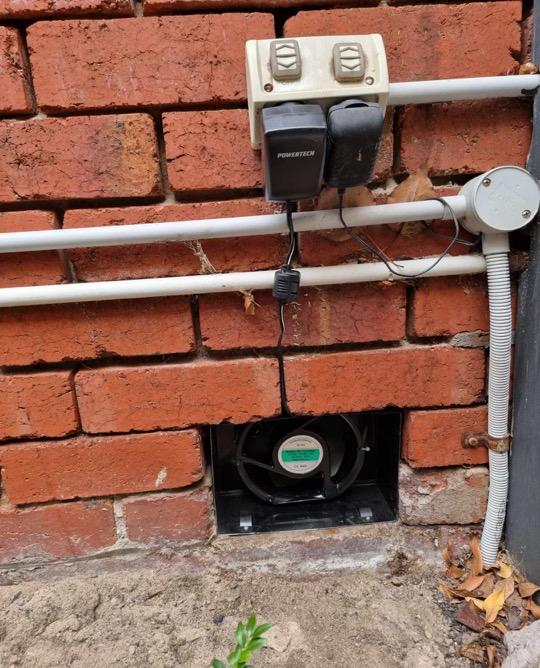
Installing a subfloor ventilation system can significantly aid in combating subfloor dampness. Ventilation systems help introduce fresh air into the subfloor area, improving air circulation and reducing moisture levels. These systems play a crucial role in preventing rising damp and mould growth, enhancing the overall air quality within the building. Some benefits of installing a subfloor ventilation system include:
- Prevention of dampness: By circulating fresh air into the subfloor area, a ventilation system helps to reduce moisture levels, preventing dampness and condensation from forming. This can help prevent structural damage to the building and protect wooden floorings from rotting.
- Reduction of mould and mildew growth: Excess moisture in the subfloor area can lead to the growth of mould and mildew, which can have adverse effects on health and contribute to allergies and respiratory issues. A ventilation system helps to control moisture levels, reducing the risk of mould and mildew growth.
- Improved air quality: By introducing fresh air into the subfloor area, a ventilation system helps to remove stale and musty air, improving overall air quality within the building. This can create a healthier living environment for occupants and reduce the risk of respiratory problems.
- Energy efficiency: Proper subfloor ventilation can help regulate temperatures within the building, making it easier to maintain a comfortable indoor climate. This can lead to energy savings by reducing the need for heating and cooling systems to work harder to compensate for moisture and humidity issues.
Adequate subfloor ventilation offers numerous benefits, including preventing health risks associated with dampness such as respiratory issues caused by mould spores. By ventilating the subfloor, you can effectively dry the area, preventing mould and mildew from thriving and causing further damage.
Signs of Rising Damp and Subfloor Moisture Issues
Subfloor damp and rising damp can cause problems in homes, but there are signs to watch for. One common sign of subfloor damp is a musty smell in the house, especially in lower areas like basements.
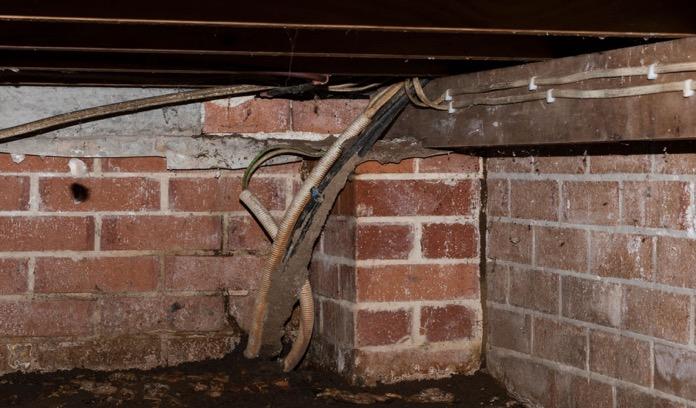
If you notice damp or wet patches on walls or floors, it could be a sign of rising damp, where moisture moves up through walls. Look out for peeling paint or wallpaper, as this can indicate dampness affecting the surface.
Another sign of subfloor damp is mould or mildew growth, which thrives in damp environments. Keep an eye out for dark patches or fuzzy growth on walls or ceilings. Rising damp can also cause salt deposits on walls, known as efflorescence, which appear as white, powdery marks. Additionally, if you see damp or stained skirting boards or flooring, it may be a sign of moisture issues in the subfloor or rising damp affecting the lower parts of the walls.
To address subfloor damp and rising damp, it’s essential to identify and fix the underlying causes. Poor ventilation in the subfloor area can lead to dampness, so ensuring proper airflow is crucial. Rising damp often stems from issues like damaged damp-proof courses or blocked gutters, so addressing these issues can help prevent further moisture problems.
Common Areas Affected by Rising Damp
Rising damp can affect various areas in a home, causing damage and creating unhealthy living conditions. Common areas where rising damp is often seen include walls, floors, ceilings, and basements. Walls may show signs of dampness, such as watermarks, peeling paint, or bubbling wallpaper, especially at the base near the floor. Floors can become damp and cold to the touch, with visible stains or mould growth in severe cases.
Ceilings are also susceptible to rising damp, often showing water stains or discoloration. This can lead to paint peeling or plaster deteriorating over time. Basements, being at a lower level, are particularly prone to rising damp due to their proximity to the ground. Signs may include damp patches on walls, musty odours, or even visible mould growth. Addressing rising damp in these common areas is essential to prevent further damage and maintain a healthy indoor environment.
Benefits of Adequate Sub floor Ventilation
Adequate subfloor ventilation offers numerous benefits for your home and overall well-being. By ensuring proper airflow beneath your house, you can prevent issues like dampness, mould, and musty odours. Good subfloor ventilation helps to keep the air fresh and dry, creating a healthier living environment for you and your family.

One significant advantage of adequate subfloor ventilation is the prevention of structural damage to your home. By reducing moisture levels under the house, you can protect wooden structures from rot and decay. This helps maintain the integrity of your home’s foundation and subfloor, potentially saving you from costly repairs in the long run.
Furthermore, proper subfloor ventilation can contribute to energy efficiency in your home. By allowing air to circulate effectively, you can regulate indoor temperatures more efficiently, reducing the need for excessive heating or cooling. This not only helps lower energy bills but also minimises environmental impact by decreasing energy consumption.
Importance of Regular Subfloor Inspections
Regular subfloor inspections are essential in identifying inadequate ventilation and addressing rising damp issues promptly. Services offering free inspection in Melbourne can help homeowners detect and prevent sub floor dampness, ensuring the longevity of the building structure.
Preventive measures such as installing subfloor ventilation systems and addressing rising damp promptly can mitigate the risks associated with subfloor dampness. These measures help in maintaining a dry and healthy subfloor area, preventing potential damage and preserving the building’s structural integrity.
Solve Your Rising Damp Issues with a Ventis Subfloor Ventilation System
Introducing the Ventis Subfloor Ventilation System, a comprehensive solution designed to enhance airflow and moisture control in your subfloor area. With options for 1, 2, or 3 fan units, this system works by creating a ventilation flow that introduces fresh outside air while expelling damp subfloor air. By effectively managing moisture levels, this system helps prevent issues like mould, musty odours, and structural damage caused by excess dampness.
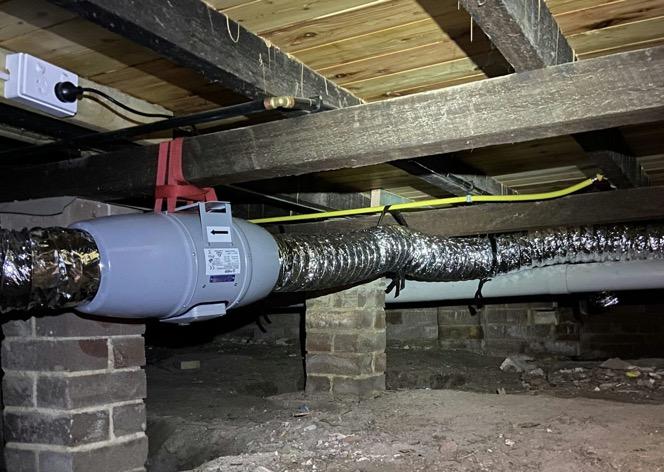
Upon placing your order, our team will reach out to ensure that the chosen system is suitable for your home, guaranteeing that you achieve the desired ventilation outcomes. For added convenience, we offer professional installation services to ensure a seamless setup, with a pre-install check conducted on your property to optimise the effectiveness of the ventilation system. You can trust Ventis Subfloor Ventilation System for a reliable, efficient, and tailored solution to improve ventilation and moisture control in your home.
Ventis Related Products
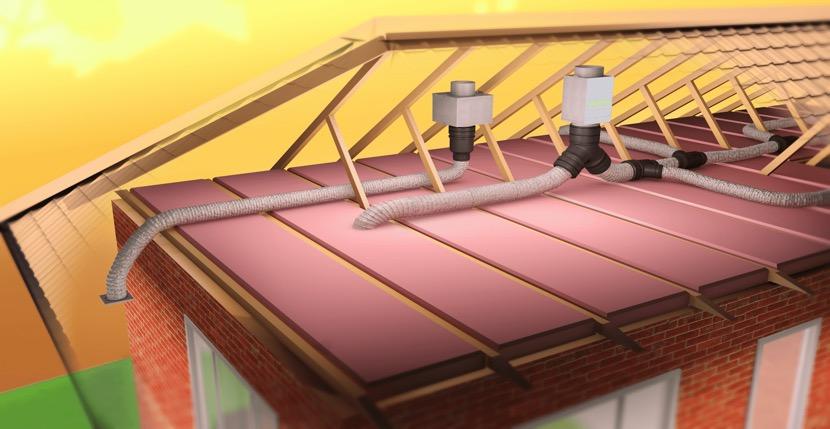
Auto Whirly for Ventis •
$1,320.00
Add to cart

Ventis Ventilation System •
$3,734.50 – $6,572.50
Add to cart
FAQ's
A: To fix a damp subfloor, you need adequate ventilation in the subfloor space. Installing a sub floor ventilation system or sub floor ventilation kits can help remove excessive moisture and allow the moisture to go.
A: A damp subfloor refers to a subfloor area that is wet due to ground moisture from underneath raised floors. Depending on the severity, visible signs of moisture may be present, causing rising damp. It is crucial to remove moisture from underneath to prevent serious health issues.
For a bathroom, you need a properly sized exhaust fan that can effectively remove excess moisture, odours, and pollutants. The fan should be selected based on performance, style, and features, with the correct air movement capacity measured in cubic feet per minute (CFM). The fan should ideally have a noise level rating of 1.0 sones or less for quiet operation.
A: Rising damps are caused by increased levels of moisture in the subfloor due to fast drying ground surfaces. This moisture will continue to wick up into the walls and inside your home, leading to dampness and potential mould growth. When rising damps occur, they can bring soluble salts from the ground up into the walls, causing damage and deterioration. Using a trailer mounted system to extract excess moisture is always best to prevent further issues and maintain a healthy environment.
A: Common signs of a damp subfloor include musty odours, visible mould or mildew, rotting of wooden structures, and damp patches on walls or floors.
A: If you have a damp sub floor area, it’s important to fix the problem quickly and efficiently to prevent further damage. One solution is to remove ground moisture from underneath the floor level. This can be achieved by using rising damp solutions such as a damp course or improving ventilation to allow air from the sub floor to circulate.
A: Moisture under a subfloor can be prevented by ensuring proper ventilation and drainage around the foundation of your home. If the subfloor is poorly ventilated, moisture can accumulate and cause water damage to the floorboards and joists. Efforts should be made to address any masonry or brick work near the ground that could be contributing to the issue.
A: Lack of ventilation traps moisture in the subfloor, creating a conducive environment for rising damp where water is drawn up through the building materials.
A: Implementing a subfloor ventilation system, installing passive vents, using drying equipment, and ensuring adequate air flow are effective solutions to combat rising damp in a subfloor.
A: Subfloor drying involves removing excess moisture in the subfloor area, which helps prevent rising damp by eliminating the conditions that promote dampness and mould growth.
A: A free inspection can help identify ventilation problems, assess the extent of moisture in the subfloor, and recommend appropriate solutions to prevent rising damp and maintain a healthy subfloor environment.
A: Moisture rising in subfloors due to inadequate ventilation can result in structural damage, decay of building materials, health hazards from mould growth, and infestations by pests attracted to damp environments.
A: Cross-flow ventilation introduces fresh air into the subfloor area and facilitates the removal of damp air, helping to dry the subfloor and prevent the build-up of moisture that leads to rising damp issues.
Popular Posts
 Derek Recsei2024-04-04Great service, Soul did everything required with patience and professionalism.
Derek Recsei2024-04-04Great service, Soul did everything required with patience and professionalism. Geraldine2024-03-27Very helpful, pleasant, prompt young technician. . thankyou
Geraldine2024-03-27Very helpful, pleasant, prompt young technician. . thankyou bill knox2024-03-26Annual filter change. Actually I’ve left it two years - just about at spend of its life. $220 (filter was $110) expensive? maybe but included a full check of system. Arrangements were well organised with arrival notice and all on time . Ventis system over 10 years old and still pumping - works a dream. Looking at upgrading hot air venting with a whirlybird - this was recommended years ago! Think it’s well overdue Todays bouquet Task: exhaust hot air from house / roof cavity Thought it would need a roof vent - but Good advice from Mark Reviewed / enhanced / rerouted the whirly and ceiling vents = more efficient More than good advice - many thanks
bill knox2024-03-26Annual filter change. Actually I’ve left it two years - just about at spend of its life. $220 (filter was $110) expensive? maybe but included a full check of system. Arrangements were well organised with arrival notice and all on time . Ventis system over 10 years old and still pumping - works a dream. Looking at upgrading hot air venting with a whirlybird - this was recommended years ago! Think it’s well overdue Todays bouquet Task: exhaust hot air from house / roof cavity Thought it would need a roof vent - but Good advice from Mark Reviewed / enhanced / rerouted the whirly and ceiling vents = more efficient More than good advice - many thanks Elizabeth Wilson2024-03-22Loving my Ventis! I am Asthmatic and with a lot of building going on around me, Ventis keeps the air in my home filtered and good for my health!
Elizabeth Wilson2024-03-22Loving my Ventis! I am Asthmatic and with a lot of building going on around me, Ventis keeps the air in my home filtered and good for my health! Gregory Mattes2024-03-19Soul, our service man, was friendly, and efficient. We were extremely satisfied.
Gregory Mattes2024-03-19Soul, our service man, was friendly, and efficient. We were extremely satisfied. Marilyn Scott2024-03-14Mel was good to book with and kept me updated with the technician’s visit. Tim was punctual, friendly and very helpful.
Marilyn Scott2024-03-14Mel was good to book with and kept me updated with the technician’s visit. Tim was punctual, friendly and very helpful. GrahamB2024-03-12Excellent and efficient service from start to finish
GrahamB2024-03-12Excellent and efficient service from start to finish Chat Wizz2024-03-01Can recommend ceiling ventilation system and servicing - especially in Sydney’s humidity.Google rating score: 4.6 of 5, based on 93 reviews
Chat Wizz2024-03-01Can recommend ceiling ventilation system and servicing - especially in Sydney’s humidity.Google rating score: 4.6 of 5, based on 93 reviews
Get In Touch
Related Posts

All You Need to Know About Heat Recovery Ventilation Systems (HRV) for Homes
Heat Recovery Ventilation (HRV) systems are becoming increasingly popular in modern homes due to their ability to enhance indoor air quality while maintaining energy efficiency. As homeowners strive for better ventilation solutions, understanding how HRV systems work, their benefits, and how they compare to Energy Recovery Ventilation (ERV) systems is essential. This article will provide a comprehensive overview of HRV systems for homes, including their functionality, benefits, maintenance, and their role in energy-efficient home designs like passive houses.

The 3 Types of Home Ventilation Systems You Should Consider
Home ventilation is very important for maintaining a healthy indoor environment. With various types of home ventilation systems available, understanding their functions and benefits is essential for every homeowner. In this article, we will explore the different types of home ventilation systems, how they improve indoor air quality, their benefits, and how to choose the right one for your needs.
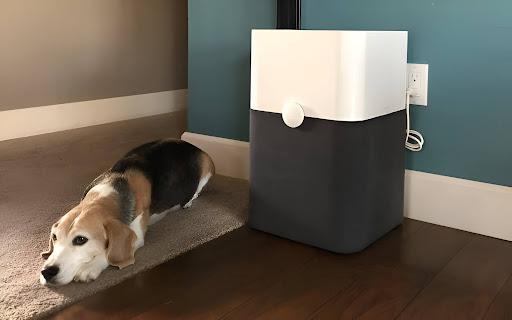
Best Air Purifiers for Pet Hair and Dander: What Pet Owners Should Consider Before Investing in One
If you have pets, you know that pet hair can be a big problem in your home. It seems to get everywhere! An air purifier for pet hair can help make your living space cleaner and more comfortable. These devices can trap pet hair and dander, which are tiny pieces of skin that pets shed. By using an air purifier, you can reduce allergies and keep the air fresh.

